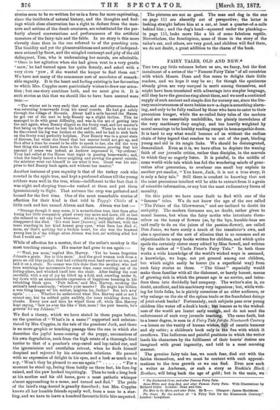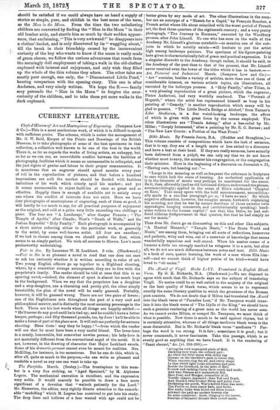FAIRY TALES, OLD AND NEW.* THE two gay little volumes
before us are, we fancy, but the first instalment of a series of the "Famous Fairy Tales" of all countries with which Messrs. Dean and Son mean to delight their little readers, and we hope it may be so ; for though the specimens already given are very unequal in merit among themselves, and might have been translated with advantage into simpler language, still they have the genuine ring about them, and we need a continued supply of such ancient and simple diet for nursery use, since the lite- rary omnivorousness of mere babies now-a-days is something alarm- ing, and only to be fully realized by those who have to cater to their precocious hunger, while the so-called fairy tales of the modern school are too essentially unchildlike, too plainly incredulous of the very machinery they employ, and too heavily weighted by moral meanings to be healthy reading except in homceopathie doses. It is hard to say what would become of us without the endless chain of fairy legend that reaches to us out of the past, binding young and old in its magic links. We should be disintegrated, demoralized. Even as it is, we have often to deplore the waning faith of our juvenile critics, rather than disciples, in the marvels to which they so eagerly listen. It is painful, in the middle of some world-wide tale which has fed the wondering minds of gene- ration after generation, to overhear one small boy explain to another yet smaller, "You know, Jack, it is not a true story, it is only a fairy tale." Still there is comfort in knowing that not the most precocious intellect will be able to extract from it a grain of scientific information, or any but the most rudimentary forms of morality.
On this point we have some fault to find with one of the " famous " tales. We do not know the age of the one called "The Prince of the Glowworms," and are inclined to doubt its• antiquity. The modern Germans are, no doubt, rather given to moral lessons, but when the fairy moths who intoxicate them- selves on the honey of flowers (as, by the bye, humble-bees are said really to do on the juices of the passion-flower), are called Don Juans, we have surely a touch of the translator's own, and also a specimen of the sort of allusion that is so common and so objectionable in many books written for children, and which quite spoils the certainly clever story edited by Mies Sewell, and written by the author of "Uncle Peter's Fairy Tale." In both these works a wide knowledge of the world's wicked ways is assumed, a knowledge, we hope, not yet general among our children, but which might easily be learnt (in a superficial way) from such fairy stories as these. "The Giant" especially would make them familiar with all the dishonest, or barely honest, means of growing rich in which the present age is no novice, and intro- duce them into decidedly bad company. The writer's aim is, no doubt, excellent, and his machinery very ingenious; but, while writ- ing for little folks, he is plainly conscious of an older audience, or why enlarge on the sin of the opium trade or the fraudulent doings of joint-stock banks? Fortunately, such subjects pass over young children like water off a duck's back ; but lessons as to the wicked- ness of the world are learnt early enough, and do not need the enforcement of such very juvenile teaching. The same fault, but to a lesser degree, is seen in A Fairy Tale for the Nineteenth Century —a lesson on the vanity of human wishes, full of caustic humour and sly satire ; a children's book only in the fan with which it overflows. The ludicrous and painful positions in which the writer lands his characters by the fulfilment of their hearts' desires are imagined with great ingenuity, and told in a most amusing manner.
The genuine fairy tale has, we much fear, died out with the fairies themselves, and we must be content with such approxi- mations to the true growth as we can find. Even now such a writer as Andersen, or such a story as Ruskin's Black } Brothers, will bring back the age of gold; but in the main, we 1-
• The Enchanted Crow, and other Famous Fairy Tales.
Snow-W7die and Rosy-Red, and other Famous Fairy Taies. With Illustrations by Richard Doyle. London: Dean and Son.
The Man in the Moon, and other Tales. By B—. Glasgow: James Maelehose. The Giant. By the Author of "A Fairy Tale for the Nineteenth Century." London: Longmans. should be satisfied if we could always have on hand a supply of stories so simple, pure, and childish in the beet sense of the term, as the Man in the Moon. From the time the two unbelieving children are converted by finding the "Man in the Moon" in their old lumber attic, and startle him so much by their sudden appear- ance, that exclaiming, "This is very awkward !" he disappears into a clothes'-basket, and is only discovered by its "waggling about," till the break in their friendship caused by the inconvenient curiosity of the boy who wants to know if the moon is really made of green cheese, we follow the curious adventures that result from the seemingly dull employment of taking a walk in the old-clothes' cupboard with interest and enjoyment, and only wish they filled up the whole of the thin volume they adorn. The other tales are mostly poor enough, one only, the "Discontented Little Pond," bearing comparison with the opening story. This one is after Andersen, and very nicely written. We hope the R— family may persuade the "Man in the Moon" to forgive the over- curiosity of the children, and to take them yet more walks in the dark cupboard.



































 Previous page
Previous page